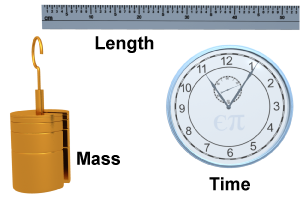|
 Three important quantities in physics are mass, length, and time. Mass describes the quantity of matter. Length describes a quantity of space, such as width, height, or distance. Time describes the flow of the universe from the past through the present and into the future. Like different languages, there are different units for each quantity.
Three important quantities in physics are mass, length, and time. Mass describes the quantity of matter. Length describes a quantity of space, such as width, height, or distance. Time describes the flow of the universe from the past through the present and into the future. Like different languages, there are different units for each quantity. 
|
Fundamental and derived quantities
|
In ancient times, systems of measure were adopted locally. One kingdom might measure distances in farthings, another in stadia, and still another in multiples of the size of the king’s hands. Over many centuries, civilizations developed common units of measure in order to facilitate communication, trade, and scientific development. The International System of Units (SI) contains seven fundamental quantities and units from which all other units can be derived. The three most important fundamental quantities for this chapter are length (or distance), mass, and time, and they are measured in units of the meter, the kilogram, and the second, respectively. These fundamental units are also referred to as base units. In later chapters of this book, you will learn about the other four fundamental quantities and their units. 
 |
In Chasing Venus: The Race to Measure the Heavens, author Andrea Wulf writes about the lack of standardized distance measures in Europe in 1761:
“...[There] was as yet no standardized measurement on Earth: An English mile was a different length from a mile in German-speaking countries—which also varied between northern German and Austria. A mil in Sweden was more than ten kilometers, in Norway more than eleven, while a French league could be three kilometers but also as much as four and a half. In France alone there were 2,000 different units of measurement—which varied even between neighboring villages.” 
|
Fundamental units and physical quantities in the
International System of Units | Physical quantity | Quantity symbol | Fundamental unit | Unit symbol |
|---|
| Mass | m | kilogram | kg | | Length | x, d, l | meter | m | | Time | t | second | s | | Electric current | I | ampere | A | | Temperature | T | kelvin | K | | Luminous intensity | Iv | candela | cd | | Amount of a substance | n | mole | mol |
|
How about speed? Speed is not a fundamental quantity—it is a derived quantity, representing distance divided by time. Fundamental quantities can usually be measured directly, such as with a meter rule, whereas derived quantities are often calculated from other measured quantities. 
|
Area is a derived quantity because it is the product of length times length (because width is a length). Similarly, volume is a derived quantity, because it is length times length times length. How about miles per gallon? The word “per” should be a giveaway that one quantity is being divided by another. For example, mpg is length (miles) divided by volume (gallons or length cubed) and is a derived quantity. 
|
| |
|

